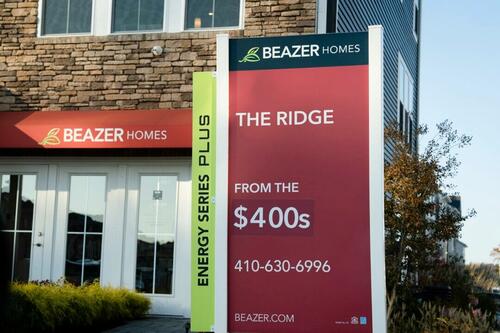Homebuyer's Down Payment Hits 'Record High,' Surging Nearly 15 Percent In A Year
Authored by Naveen Athrappully via The Epoch Times (emphasis ours),
The median down payment for buying a home in the United States has jumped to an all-time high, driven by factors like high home prices and mortgage rates, according to a report by real estate brokerage Redfin.

“The typical down payment for U.S. homebuyers hit a record high of $67,500 in June, up 14.8 percent from $58,788 a year earlier,” according to an Aug. 28 news release. Year-over-year down payment costs have been rising continuously over the past months, with June recording the 12th straight month of increase.
Redfin said the spike in down payment was being influenced by current market conditions where “higher-priced, turnkey homes” located in desirable neighborhoods are likely to get sold. Turnkey homes are fully renovated properties that an investor can buy and rent out immediately.
The median price of a U.S. home was also at a “record” high of $442,525. With elevated home prices and mortgage rates, buyers need to put down more money in down payment.
“Investors are still coming in with all-cash offers on homes that need to be renovated. Traditional buyers are putting up large down payments to try and lower their mortgage payment,” said Annie Foushee, a Redfin agent in Denver.
“These buyers will often utilize the help of family members to put down more than they could on their own.”
The down payment a typical homebuyer made in June was 18.6 percent of the home price, the highest level in more than a decade. Almost three in five buyers paid more than 10 percent of the property price as a down payment in June.
More than 30 percent of home purchases in June were made all-cash, up from last year. Redfin Senior Economist Sheharyar Bokhari pointed out that the “percentage of all-cash sales generally follows the same trend as the rise and fall of mortgage rates. When rates are down, the percentage of all-cash sales is down too, and the opposite is true when rates go up.”
“That means we may start to see all-cash purchases level off a little now that mortgage rates have started to come down from recent highs.”
According to real estate data provider ATTOM, Barnstable Town, Massachusetts, had the highest median down payment percentage for home purchases among all U.S. metros in the first quarter of this year at 23.6 percent.
Naples-Immokalee-Marco Island, Florida, and San Francisco-Oakland-Hayward, California, had rates above 23 percent. Los Angeles-Long Beach-Anaheim, California; Boulder, Colorado; Santa Rosa, California; and Oxnard-Thousand Oaks-Ventura, California are the other metros that came over 20 percent.
Housing Affordability
Higher down payment is one of the factors contributing to the affordability crisis in the housing sector.
Data from the National Association of Realtors (NAR) show that in June, to afford a median-priced existing single-family home, a person had to make monthly payments of $2,303, which is almost double the $1,206 in payments from 2021.
Monthly payments now eat up more than a quarter of an individual’s income. To simply qualify for the home, the person needs to have an income of $110,544, up from $57,888.
A key factor making home loans expensive is mortgage rates, which have jumped from 3.01 percent to seven percent during this period.
In recent months, rates have declined from their peak in late October. The average 30-year fixed-rate mortgage rate was 6.35 percent for the week ending Aug. 29.
Sam Khater, chief economist at Freddie Mac, said mortgage rates declined in the recent week due to “expectations of a Fed rate cut.”
“Rates are expected to continue their decline, and while potential homebuyers are watching closely, a rebound in purchase activity remains elusive until we see further declines.”
Even when rates come down, high home prices could continue to be the norm, keeping housing costs elevated.
In a recent interview with The Epoch Times, Jessica Lautz, NAR deputy chief economist and vice president of research, said the organization was “forecasting that home prices will continue to grow based on the lack of inventory and demand for home ownership.”

